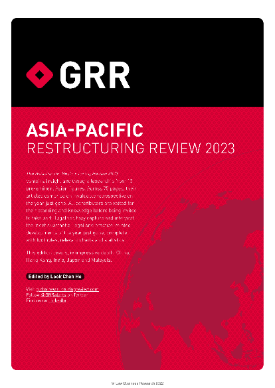-
Articles
An introduction to court procedures for insolvency in Japan
An Introduction to Court Procedures for Insolvency in Japan
Q1. What is the outline of court procedures for insolvency in Japan?
Q2. What is the outline of bankruptcy proceedings?
Q3. What is the outline of civil rehabilitation proceedings?
Q4. What is the outline of corporate reorganization proceedings?
Q5. What are the effects of the petition and the commencement of court procedures for insolvency?
Q6. What is the position and power of a court-appointed trustee/supervisor in insolvency procedures?
Q7. What are the classifications of claims and their order of priority?
Q8. What is a creditors’ committee?
Q9. How are security interests handled in court procedures for insolvency?
Q10. What are the procedures for the investigation and determination of claims?
Q11. How are debtor’s assets disposed of and converted into money in court procedures for insolvency?
Q12. What kinds of acts conducted by the debtor before the commencement of insolvency procedures may be deemed invalid after the commencement order is given, and thus shall be avoided in court?
Q13. What points should one pay attention to when one asserts set-offs?
Q14. How is an Executory Contract treated in court procedures for insolvency?
Q15. If a clause, which gives a counterparty of a debtor the right to terminate a contract where the debtor files for a petition for commencement of court procedures for insolvency, is prescribed by the contract, is it possible to terminate the said contract?
Q16. What will happen to a debtor if a proposed rehabilitation plan or reorganization plan is rejected by creditors?
Q17. Is it possible for the effect of foreign insolvency proceedings to have influence over the proceedings in Japan?
Q18. What is the outline of “Turnaround ADR”?
Q1. What is the outline of court procedures for insolvency in Japan?
A. Court procedures for insolvency in Japan are categorized into liquidation procedures, including bankruptcy and special liquidation proceedings, and restructuring procedures, including civil rehabilitation and corporate reorganization proceedings. These four proceedings are promulgated by separate acts; bankruptcy proceedings by the Bankruptcy Act, special liquidation by a part of the Companies Act, civil rehabilitation proceedings by the Civil Rehabilitation Act, and corporate reorganization proceedings by the Corporate Reorganization Act.
| In-court Liquidation Procedure | Bankruptcy Proceedings under the Bankruptcy Act |
| Special Liquidation under the Companies Act | |
| In-court Restructuring Procedure | Civil Rehabilitation Proceedings under the Civil Rehabilitation Act |
| Corporate Reorganization Proceedings under the Corporate Reorganization Act |
Bankruptcy proceedings are similar to the proceedings prescribed in Chapter 7 of the US Bankruptcy Code. In this procedure, a court-appointed trustee disposes of the assets of the debtor and builds up a bankruptcy estate. The trustee makes distributions to creditors according to the priority order prescribed by law during the final stage of the proceedings, and approval by creditors is not needed for the said distribution.
Special liquidation is a procedure whereby insolvent stock companies can liquidate. Compared to bankruptcy proceedings, a debtor continues to have the power to dispose of its assets in the special liquidation and the competent court does not appoint a trustee to the debtor who filed for special liquidation. The debtor will make distributions to creditors according to the plan approved by the creditors on a two-thirds majority basis at the creditors’ meeting and confirmed by the court.
Both civil rehabilitation proceedings and corporate reorganization proceedings are similar to the proceedings prescribed in Chapter 11 of the US Bankruptcy Code. In civil rehabilitation proceedings, as a general rule, a debtor continues to have the power to manage its business and dispose of its assets even after an order for rehabilitation proceedings has commenced (“DIP”).
On the other hand, in corporate reorganization proceedings, as a general rule, the debtor’s business is managed by a court-appointed trustee instead of the debtor. This is a procedure to impair not only the claims of unsecured creditors, but also the claims of secured creditors.
In both procedures, distributions to creditors will be made after the rehabilitation plan or the reorganization plan is approved by a statutory majority at the creditors’ meeting, and the plan is confirmed by the court.
With regard to English translations by the Japanese government of provisions of the Bankruptcy Act, Civil Rehabilitation Act, and Companies Act, please refer to the Following URLs:
Q2. What is the outline of bankruptcy proceedings?
A. Bankruptcy (hasan) is a procedure to liquidate the business of a debtor who is unable to pay all debts by disposing of all of their assets and making distributions to creditors. This procedure is applicable to both individuals and corporations.
Bankruptcy procedures can be filed by both debtors and creditors. In the later case, which is called an “involuntary petition”, the petitioner is not required to have a substantial portion of the claims, and may file such petition regardless of the amount of claims.
After a petition for commencement of bankruptcy proceedings for a corporation is filed with the court, the court orders the commencement if; (1) a debtor is generally and continuously unable to pay their debts already due because of the lack of ability to pay, or (2) a debtor’s debts exceed its assets.
Once the bankruptcy proceedings have commenced by the court, the debtor is prohibited from paying any debts to the creditors. Instead, payments to creditors are made by the trustee only through distribution proceedings, as provided for by the Bankruptcy Act.
The court appoints a trustee simultaneously with the order of commencement of the bankruptcy proceedings, and specifies the period within which the claim should be filed by creditors and the date of the creditors’ meeting. The duties of the trustee are to convert the assets of the debtor into cash so that distributions to creditors can be made, and to also examine proofs of claims which creditors file to the court, and to object to the allowance of any claims that are improper. A creditors’ meeting is held on a date decided by the court, and the financial status of the estate of the debtor and the activities conducted by the trustee are reported to the creditors by the trustee. Then, if the bankruptcy estate is large enough for distributions to be made, distributions are made in the order of priority described in the Bankruptcy Act.

Q3. What is the outline of civil rehabilitation proceedings?
A. The purpose of the civil rehabilitation (minji-saisei) proceedings is to enable a distressed debtor to rehabilitate, and this procedure is applicable to both individuals and corporations.
When a petition for commencement of civil rehabilitation proceedings is filed, the court orders a preservation order which prohibits the debtor from paying any debts to the creditors as a general rule. However, exercising any security interest is not prohibited by the Civil Rehabilitation Act, and thus secured creditors may collect their claims by exercising their security interests regardless of the filing of the civil rehabilitation proceedings.
Under the civil rehabilitation proceedings, the court does not appoint a trustee as a rule, and the debtor remains in control and has the power to manage its business. However, in most cases, a supervisor is appointed by the court to monitor the debtor’s activities. The debtor is required to obtain approval from the supervisor in order to conduct actions other than in the ordinary course of business.
The court shall order commencement of the civil rehabilitation proceedings in the following cases, if (1) there is a risk that a debtor will not be able to pay its debts as they become due, or that a debtor’s debts exceed its assets, or (2) the debtor is unable to pay its debts already due without causing significant hindrance to the continuation of their business. However the petition for the commencement is dismissed if the court finds that, (i) the debtor is unlikely to prepare a rehabilitation plan, (ii) the said plan is unlikely to be approved by the creditors, or (iii) the said plan is unlikely to be confirmed by the court. A commencement order will normally be issued within a week after the filing. In addition, before the commencement order is given, an explanatory meeting for the creditors is usually held by the debtor to explain (a) how and why the petition was filed with the court, and (b) the outline of the civil rehabilitation proceedings.
Once the civil rehabilitation proceedings have commenced by the court, unsecured creditors (including secured creditors with a claim that will exceed the value of security interests that the secured creditors have, meaning the amount which cannot be collected by exercising the security interest), should file their proofs of claim with the court by the court-specified date.
The debtor will then examine the amount of each unsecured claim in order to prepare and submit to the court a list of claim holders, in which the debtor expresses their opinion as to whether to approve or object to the proofs of claim. Additionally, for submission to the court, the debtor evaluates the assets and debts based upon a price which assumes that they are disposed of immediately as of the time the rehabilitation proceedings commence, and prepares a balance sheet based on the above evaluation accordingly. The debtor will also prepare a report for the court containing information such as reasons for the petition and the circumstances of the debtor’s business. The debtor prepares a civil rehabilitation plan, which provides for impairment of the unsecured creditor’s rights, the amount and timing of the payment, etc., and the unsecured creditors determine whether or not to approve the proposed plan at the creditors’ meeting. The rehabilitation plan will be approved when it obtains (1) the consent from the majority of voting right holders who are in attendance at the creditors’ meeting (including creditors who have voted in advance by completing the necessary form), and (2) the consent of creditors who hold voting rights that account for not less than one-half of the total amount of voting rights, and will become effective if the court confirms the plan. Subsequently, the debtor pays off its debts according to the plan, and will be discharged from the rest of its debts.
The process usually takes approximately five months from the time of petition for the commencement to the time the plan is confirmed.

Q4. What is the outline of corporate reorganization proceedings?
A. The purpose of the corporate reorganization (kaisha-kosei) proceedings is to enable a distressed debtor to reorganize its business, and it is only applicable to stock companies. In practice, it tends to apply only to large-scale stock companies.
A petition for commencement of corporate reorganization proceedings may be filed not only by the debtor, but also by creditors and shareholders. If the petition is filed by a creditor, they are required to have an amount of claim which accounts for not less than one-tenth of the amount of stated capital of the debtor. On the other hand, if the petition is filed by a shareholder, the shareholder is required to hold voting rights that account for not less than one-tenth of the total voting rights held by shareholders.
Once the petition for corporate reorganization proceedings is filed, the court will make a provisional administration order which prohibits the debtor from paying any debts to the creditors as a general rule. The court will also make an order staying the exercise of security interests in some cases.
The court appoints a provisional administrator in the provisional administration order. The provisional administrator has the sole authority to administer and dispose of the debtor's assets from the time the petition is filed until the commencement of the proceedings is ordered, but needs the approval of the court to conduct actions other than the debtor’s ordinary course of business.
After the petition for commencement of the corporate reorganization proceedings is filed with the court, an explanatory meeting for creditors is held voluntarily by the debtor in most cases before the court orders the proceedings to commence.
The court shall order the corporate reorganization proceedings to commence in the following cases, if (1) there is a risk that the debtor will not be able to pay its debts as they become due, or that the debtor’s debts exceed its assets, or (2) the debtor is unable to pay its debts already due without causing significant hindrance to the continuation of its business. However the petition is dismissed if (i) it is obvious that the debtor is unlikely to prepare a reorganization plan, (ii) the said plan is unlikely to be approved by the creditors, or (iii) the said plan is unlikely to be confirmed by the court. It generally requires approximately a month from the time of the petition for the commencement order to be issued.
Once the court orders the corporate reorganization proceedings to commence, in principle, the debtor is prohibited from paying the unsecured claims, priority claims and secured claims, but instead, distribution payments to the creditors are made by the trustee according to the reorganization plan. The exercise of security interests are also prohibited in corporate reorganization proceedings, while they are allowed in civil rehabilitation and bankruptcy proceedings.
The court appoints a trustee simultaneously with the order to commence the corporate reorganization proceedings. The trustee has the sole authority to administer, and dispose of the assets of the debtor and its estate. In most cases, the court appoints the provisional administrator as the trustee. The trustee is required to be obtain court approval to do certain important actions which do not fall within the ordinary course of business.
Creditors may file a proof of claim by the date specified by the court, and the trustee will then examine the amount of each claim in order to prepare and submit to the court a list of claim holders, in which the trustee expresses their opinion whether to approve or object to the proofs of claim.
The trustee evaluates the assets and the debts based upon the market price as of the date the reorganization proceedings commence in order to prepare and submit a balance sheet based on the above evaluation to the court. The trustee prepares a corporate reorganization plan, describing the distribution percentage to the creditors, etc., and each class of creditors determines whether or not to approve the proposed plan. Under the corporate reorganization proceedings, the creditors’ claims are generally divided into two classes: unsecured claims/priority claims, and secured claims, and the requirements for the approval of the proposed reorganization plan differ with each class.
With respect to unsecured creditors, the reorganization plan must obtain the consent of persons who hold voting rights that account for more than one half of the total voting rights held by unsecured claim holders.
On the other hand, with regard to secured creditors, in order to extend the due date of the payment of secured claims, the consent of persons who hold voting rights that account for not less than two-thirds of the total voting rights held by secured claim holders is required. Also, in order to write off secured claims to some extent, the consent of persons who hold voting rights that account for not less than three-quarters of the total voting rights held by secured claimholders is required. Shareholders do not have the right to vote where the debtor’s debts exceed its assets. (Therefore, in practice, shareholders do not have voting rights in most cases.)
After the plan is approved by creditors, the plan will become effective if the court confirms the plan. Subsequently, the debtor pays off its debts according to the plan, and the rest of its debts will be discharged.
Altogether, the process normally takes approximately a year from the time of the petition to when the plan is approved.
Although the management of the debtor’s business is generally replaced by a court-appointed trustee who is a well experienced insolvency lawyer without any interests in the debtor, under the corporate reorganization proceedings, these days there are cases where a person who is in charge of the debtor’s business before the petition is appointed by the court as a trustee, and the said individual continues to manage the business even after the reorganization proceedings have commenced. In such case, the court appoints a third party as an examiner or a supervisor who oversees the management personnel.

Q5. What are the effects of the petition and the commencement of court procedures for insolvency?
A. 1. The Petition and the Commencement
In Japan, court procedures for insolvency are not commenced automatically by the filing. More specifically, the said procedures are commenced by the court’s order, which is made if the court examines and finds facts constituting grounds for the commencement of each procedure such as the debtor’s insolvency, risk of insolvency, possibility of rehabilitation, etc. Therefore, it takes a certain amount of time for the commencement of each procedure to be ordered, and the timing of the commencement varies depending on each case. However, in cases where the proceedings are filed by the debtor, the commencement order is generally given on the same day or within a few days in bankruptcy proceedings, within about a week in civil rehabilitation proceedings, and within about a month in corporate reorganization proceedings. On the other hand, in involuntary petitions where a creditor files proceedings, though the timing of the commencement of procedures varies depending on the case, it is not uncommon for the commencement to take several weeks or several months. This is because, in most cases, the debtor usually asserts that they are not insolvent.
2. The Effect of the Petition Contrary to the proceedings in the United States where an “automatic stay” is provided for, collection of debts by creditors is not automatically prohibited as an effect of the filing for court insolvency procedures by a debtor or a creditor in Japan. However, in in-court restructuring procedures, the court commonly prohibits actions to collect debts by creditors until the order for commencement is given.
When a petition for commencement of civil rehabilitation proceedings is filed with the court, the court generally appoints a supervisor, and the debtor is required to obtain consent from the supervisor in order to engage in certain important conduct. On the other hand, in general, the court orders a provisional administration order and appoints a provisional administrator, to whom the sole authorization to administer and dispose of the debtor's property belongs in the case of corporate reorganization proceedings.
3. The Effect of the Commencement
Once the court orders the commencement of court procedures for insolvency, any actions by creditors to collect debts from a debtor are prohibited, and any ongoing judicial procedures including litigations and execution proceedings will be suspended. In addition, security interests can be exercised even after the court procedure for insolvency have commenced under the civil rehabilitation proceedings, bankruptcy proceedings, and special liquidation, while it is prohibited in corporate reorganization proceedings.
Simultaneously with the commencement order, the court also specifies the period within which creditors may submit their proofs of claims to the court. Therefore, at the time of the commencement, the creditors are given information about the date by which they may submit their proofs of claim.
Moreover, the trustee, the supervisor, and the debtor who is under court procedures for insolvency may use their powers vested by the law, such as the power of avoidance (please refer to the answer on Q12), and the power to terminate executory contracts (please refer to the answer on Q14).
Q6. What is the position and power of a court-appointed trustee/supervisor in insolvency procedures?
A. In Japan, the court generally appoints attorneys with broad experience in the field of insolvency proceedings as trustees and supervisors.
1. A Supervisor in Civil Rehabilitation Proceedings
A court-appointed supervisor oversees the conduct of the debtor under the Civil Rehabilitation Proceedings. As described in Q1, in civil rehabilitation proceedings, the debtor in possession (the rehabilitation debtor) generally remains in control, and has the power to manage its business and dispose of its assets even after the commencement of the rehabilitation proceedings. After the court appoints a supervisor, any actions that the court designate in the commencement order will require the supervisor’s consent. The court-appointed supervisor monitors the rehabilitation debtor’s conduct by examining each application for consent. The ordinary course of business of the rehabilitation debtor is generally excluded from the actions that need the supervisor’s consent.
The supervisor also has a duty and power to express their opinion in regards to the report prepared by the rehabilitation debtor concerning the financial status of the debtor and the investigation of liabilities associated with its managements’ misconduct. In addition, the supervisor is also required to express an opinion to the court regarding the debtor’s proposed rehabilitation plan. Upon considering the supervisor’s opinions, the court then decides whether the proposed rehabilitation plan is adequate and legitimate. After the rehabilitation plan is approved according to the Civil Rehabilitation Act, the supervisor will oversee the implementation of the rehabilitation plan.
In civil rehabilitation proceedings, acts prejudicial to the rehabilitation creditors are avoided, and the supervisor has power to avoid such acts (“the right of avoidance”. For details on the right of avoidance, please refer to Q12.). The debtor, on the other hand, does not have such power.
2. A Trustee in Bankruptcy Proceedings and Corporate Reorganization Proceedings
A court-appointed trustee in the bankruptcy proceedings and the corporate reorganization proceedings has the sole authority to administer and dispose of the assets of the debtor and its estate. (On the other hand, in civil rehabilitation proceedings, the court appoints a trustee only in rare cases such as when the property management by the debtor is inadequate.) The trustee also has the right of avoidance, and the right to cancel executory contracts (For details on executory contracts, please refer to Q14.) In bankruptcy proceedings, the trustee makes distributions to the creditors, whereas in corporate reorganization proceedings, the trustee prepares and implements a reorganization plan. A single trustee is generally appointed in bankruptcy proceedings, while it is usual that two trustees (one in charge of the legal aspects of the proceeding, and the other in charge of the business aspect) are appointed in corporate reorganization proceedings. In this case, an attorney-at-law is usually appointed as the “legal trustee”, and a business person from a company sponsoring the debtor is dispatched as the “business trustee”.
A provisional administrator is appointed, mainly in corporate reorganization proceedings, to secure the debtor’s properties and estate from the time of petition for commencement of corporate reorganization proceedings up until the order for commencement of the proceedings is given. The provisional administrator has the sole power to administer and dispose of the debtor's property during such term. In most cases, the provisional administrator becomes the court-appointed corporate reorganization trustee after the order for commencement of the proceedings.
Q7. What are the classifications of claims and their order of priority?
A. The classifications of claims vary between bankruptcy/civil rehabilitation proceedings, and corporate reorganization proceedings. The difference is that in corporate reorganization proceedings, secured claims and priority claims may also be impaired under the plan.
In general, claims are classified as follows: (1) administrative expenses, (2) priority claims, (3) secured claims, (4) unsecured claims, and (5) post-commencement claims. Administrative expenses are the highest-priority claims in all court procedures for insolvency, and the payment of administrative expenses may not be impaired. In other words, even after insolvency proceedings are filed, the payment of administrative expenses is given top priority compared to the payment of other claims.
Administrative expenses are fully paid as long as the debtor’s estate has sufficient cash to pay, but partially paid if the amount of the debtor’s estate is insufficient. Administrative expenses include remunerations for trustees, fees necessary to conduct the proceedings, and expenses incurred after the commencement order of the proceedings is given. In bankruptcy proceedings, some taxes and labor claims are also deemed to be administrative expenses.
Priority claims are claims given priority by law, and are given preference subsequent to administrative expenses. Priority claims may not be impaired in bankruptcy and civil rehabilitation proceedings. Priority claims are also fully paid as long as the debtor’s estate has sufficient cash to pay in those proceedings. However, in corporate reorganization proceedings, the impairment of priority claims is allowed. Priority claims in civil rehabilitation and corporate reorganization proceedings include labor claims and claims for tax.
Secured claims are claims that allow the holder of such claims to receive payments from collateral preferentially. In bankruptcy and civil rehabilitation proceedings, secured creditors are allowed to foreclose collateral and receive preferential payments without going through the proceedings, even after a petition for commencement of the proceedings is filed. See Q9 for further details.
On the other hand, the amount of the claim which exceeds the value of the security (the amount for which payment is not expected to be received by exercising the security interest), is treated as an unsecured claim, and payment will be made according to the rehabilitation/reorganization plan both in civil rehabilitation and corporate reorganization proceedings.
Unsecured claims are ordinary claims without priorities or securities. After the commencement of court procedures for insolvency, holders of unsecured claims in civil rehabilitation and corporate reorganization proceedings may only receive payments from the debtor/trustee under the rehabilitation/reorganization plan where the unsecured claims have probably been impaired. In bankruptcy proceedings, unsecured claimholders must wait until a liquidating distribution is made by the trustee in order to receive payments.
Unsecured bondholders are generally treated as unsecured claimholders, and are not given priority to other claims. Also, in cases when the debtor issued bonds appointing bond administrators (indenture trustees), certain restrictions are placed on the exercise of voting rights.
Post-commencement claims are claims that arise from a cause that has occurred after the commencement of insolvency proceedings, which do not fall under administrative expenses, priority claims, or unsecured claims. Payments of post-commencement claims may not be made until the termination of insolvency proceedings.
Q8. What is a creditors’ committee?
A. In bankruptcy, civil rehabilitation, and corporate reorganization proceedings, if there is a voluntary committee consisting of creditors, the court may approve the participation of the said committee in the proceedings. A creditors’ committee is voluntary and does not have to be established in those proceedings. In practice, it is rare for such committees to be established.
In order to receive approval from the court for the participation of the creditors’ committee, certain requirements must be fulfilled, such as meeting the minimum requirement for the number of committee members, and consent from the majority of the creditors regarding the committee’s participation in the insolvency proceedings.
After the participation of a creditors’ committee is approved, the committee may state its opinions to the court, the debtor, the trustee, the supervisor, etc., in each proceedings. The committee may also petition for the convocation of a creditors’ meeting, and request a report on certain matters from the debtor and the trustee.
The court may rescind the approval for the participation of the creditors’ committee in the proceedings at any time.
Articles
Davos
External Seminars
Articles
Articles
Tokyo
External Seminars
Articles
Related Knowledge

Chambers Global Practice Guides - Insolvency 2023: Japan

Ryutaro Nakayama and Yuri Sugano were interviewed at the World Economic Forum Annual Meeting 2023 (Davos)

MSMEs - PRACTICAL CHALLENGES AND RISK MITIGATION POST COVID-19

Chambers Global Practice Guides - Insolvency 2022: Japan

Post - pandemic M&A and Restructuring

Business Turnaround Following the Covid-19 Pandemic in Japan
